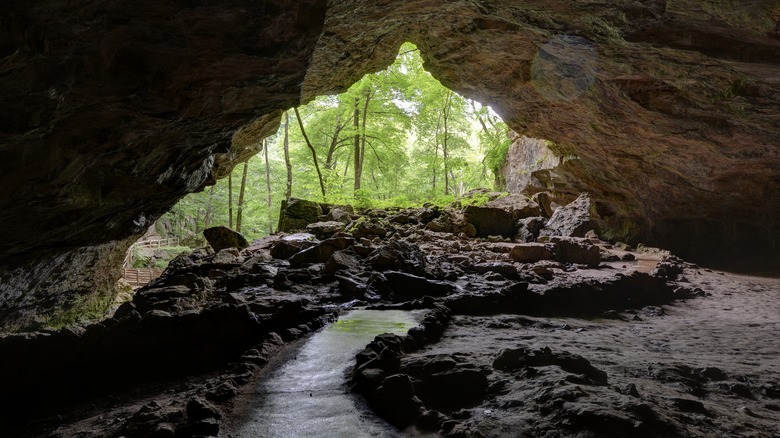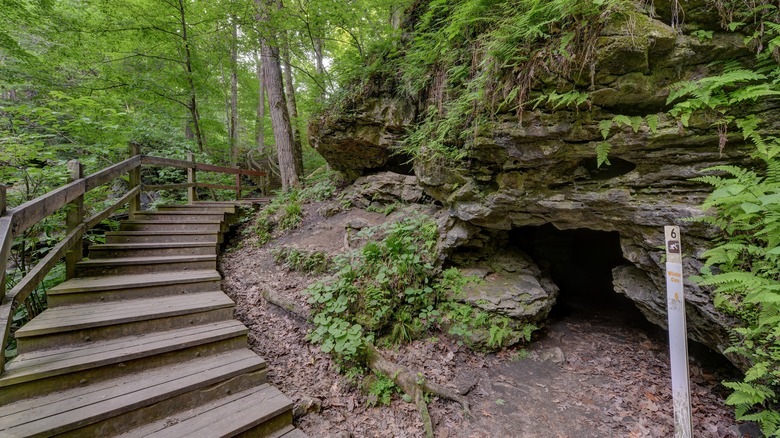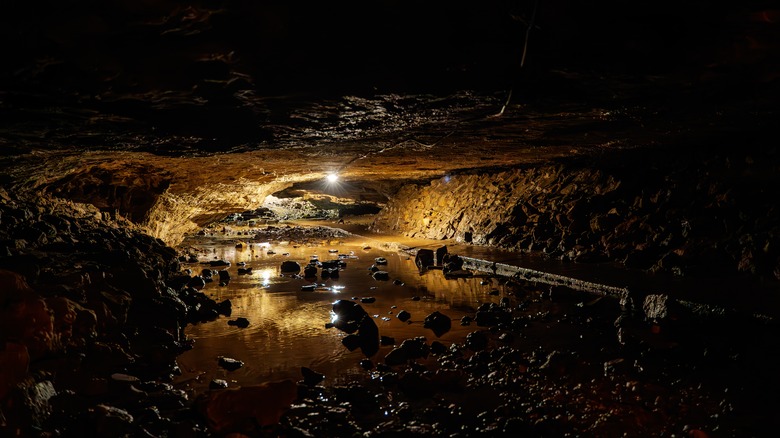Iowa's Most Unique Outdoor Attraction Is A Free-To-Visit State Park Full Of Caves
America's vast and diverse landscape is obviously incredible to witness aboveground. But descending just below the surface, you can find some equally amazing (if dark and stuffy) natural wonders in one of the country's many remarkable cave systems. From the world's longest-known cave system at Mammoth Cave National Park to unique spectacles like Ohio's striking Crystal Cave, the United States has a veritable wonderland just under the surface, waiting to be explored by amateurs and professionals alike. And while some of these caves are so dangerous that they should only be explored by professionals, others are quite accessible to the average traveler.
A great example of the latter is the complex and immersive cave system at Iowa's Maquoketa Caves State Park. With over a dozen caves inside its borders, Maquoketa Caves State Park has more public caves than any other state park in Iowa. Even better, the park's caves range from easy and accessible subterranean treks to more challenging cavern systems for experienced spelunkers. The park also features several photogenic rock formations aboveground on its convenient scenic hiking trails. And if that wasn't enough of a draw, Maquoketa Caves is completely free to enter!
Maquoketa Caves State Park is a cave-lovers paradise
Iowa is not exactly high on most people's travel bucket lists. In the popular imagination, the Hawkeye State seems like little more than endless corn fields and small rural towns. But Iowa is actually one of the country's most underrated travel destinations. Not only is Iowa one of the best states for retirees to visit, but its extensive state park system offers many of the best outdoor attractions in the Midwest. Within this superb state park system, Maquoketa Caves State Park stands out as arguably Iowa's single best natural feature, both above and below the surface.
Maquoketa Caves State Park contains 13 distinct caves over 192 acres. Most of these caves are linked via a single, convenient hiking trail. The park's largest cave, the 1,100-foot-long Dancehall Cave, is also the most accessible. Dancehall Cave has three distinct entrances, with the middle entrance featuring a manageable wooden staircase leading down to the main walking path. This path is well-paved and generally easy to navigate, though visitors should watch out for wet and slippery sections. In a few spots, you may have to hunch over to get through lower passages, but in general, the cave is large enough to accommodate even taller visitors. In fact, the cave got its name from the live concerts nearby residents used to hold there!
Other accessible caves have equally distinctive names, like "Shinbone Cave," "Rainy Day Cave," and "Hernando's Hideaway." Outside the cave system, Maquoketa Caves State Park also features aboveground geological features like a prominent balancing rock and a natural bridge. Even if you're not a huge "rock person," the surrounding forests and meadows (including a gorgeous display of wildflowers in warmer months) make a hike through Maquoketa Caves more than worth the trip.
Delve into the Maquoketa Caves on your next trip to Iowa
Maquoketa Caves State Park is located near the town of Maquoketa in Iowa's Jackson County, about an hour from Cedar Rapids. This entire region of Iowa lies in a larger geographic region of the Midwest known as the "Driftless Area," a lovely landscape around the Upper Mississippi marked by complex valleys, hills, and extensive cave systems. The Driftless Area as a whole is an underrated outdoor destination, but even in this context, Maquoketa Caves State Park stands out as one of the most epic hiking destinations in the Midwest.
The main Maquoketa Caves Loop trail is only 1.7 miles long and can usually be completed in less than an hour. Despite its short length, the trail provides an unforgettable tour across the park's incredible natural features, including its most prominent caves and photogenic rock formations. Overall, Maquoketa Caves has around 6 miles of hiking trails that let you explore the entire park at your own pace, as well as a restored prairie, an educational interpretive center, and accessible campgrounds for anyone who wants to stay overnight.
Be aware that between October and April, the park's caves are closed to public access to protect the resident bat colony during their hibernation period. But even during the winter season, you can still explore the ground-level hiking trails and take in some of the most enchanting natural beauty that Iowa has to offer.


